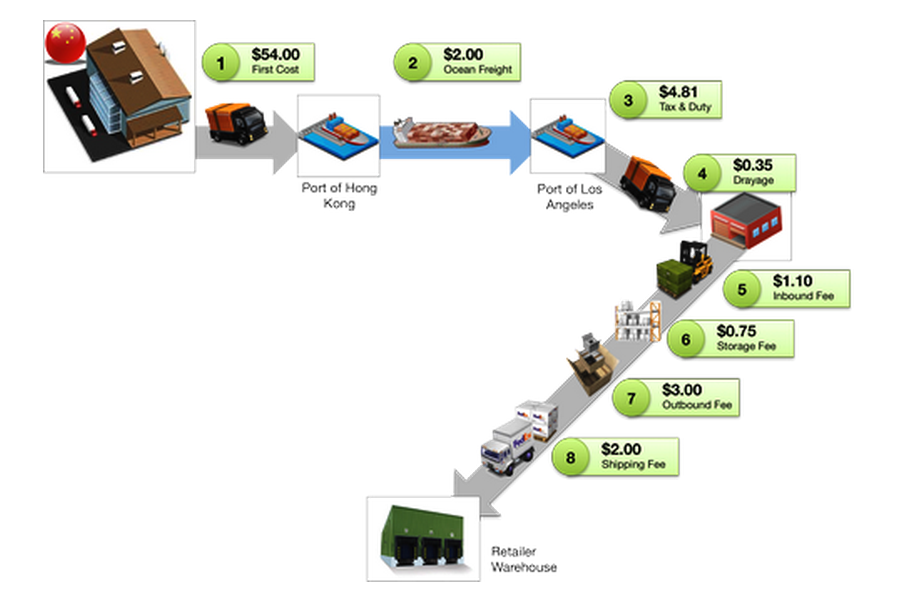Worldwide B2C (Business to Consumer) e-retailing revenues in 2014 are estimated to have reached $1.3 trillion, growing 22.2% over the previous year. Do you have your Ecommerce Shipping set?
eMarketerforecasts that B2C eCommerce will continue growing rapidly in the next few years, maintaining its share of around 6% of total retail sales. The $1.3 trillion in e-retailing revenues include an estimated $300 billion in cross-border ecommerce drop shipments. Cross-border shipments in ecommerce are growing at twice the rate of domestic transactions. Though the major international transactions at present are in developed markets between countries such as the USA and the UK or continental Europe, the majority of growth is expected to come from international ecommerce shipping to and from Asia (especially China and India) and from segments of Latin America and Africa. The growth of cross-border eCommerce drop shipping can be attributed to a number of factors:
- The rapid spread of mobile communication devices such as smartphones and tablets, especially among younger demographics, allows consumers to compare the features and pricing of products available internationally with what is available at their local stores. If the international product is superior to the local one, it is easy to order online.
- An interesting, recently identified market segment is the relatively affluent older population in the countries mentioned above, which increasingly finds that online shopping offers more choices than physical shopping.
- Online retailers present product information in a language and format similar to those of a domestic seller. For instance, some websites that sell apparel use local fashion icons, in addition to being customized in local languages.
- Online payments are increasingly simple as a result of widespread support for local credit cards and currencies.
For eCommerce, the major challenge restricting expansion is the difficulty of cross-border delivery. Shipping goods internationally is complicated by the following factors: (1) Customs Procedures The typical eCommerce business sends a large number of small consignments. The paperwork necessary for customs clearance of these consignments often requires the use of customs clearance agents, who add to the cost of delivery and often slow it down. Import regulations and customs duties change periodically, making it difficult for the e-retailer to keep track of the rules and rates applicable at the time he processes an order. A significant problem for the eCommerce industry is the refund of customs duties on goods returned by the customer, which may require additional paperwork to match the returned items to their original shipment documents. Anti-terrorism measures often require that the addresses of the shipper and receiver be pre-screened for certain types of cross-border shipments. (2) Other Legal Requirements eCommerce businesses may also be affected by other rules and laws specific to the country of delivery. For example, many countries require product labeling to be in local languages. Payments in international currency are often subject to controls. The rules relating to applicability of local taxes vary between countries and even between states or administrative regions of larger countries. In addition, product liability laws vary between countries, and it is often difficult for an e-retailer to obtain insurance to protect against product liability claims. Copyright and trademark laws can make it difficult for e-retailers to ship international brand-name products to certain countries. (3) Managing Order Fulfillment and Delivery Costs The most critical challenge that the e-retailer faces is optimizing the cost and speed of order fulfillment and delivery; this is especially important for cross-border sales. eCommerce customers want to pay as little as possible for shipment; ideally, the price of a product shown on a website will include the cost of shipping, which allows a direct comparison with product prices in local retail stores. In addition, eCommerce customers expect a firm delivery date not long after they place their order. The risk of product returns, especially on items like apparel and fashion accessories, goes up when there are significant delays in delivery. The chart below (from a blog by Mathew Carroll on quora.com) shows the cost of shipping a pair of shoes by ocean freight from a Hong Kong manufacturer to a physical retailer’s warehouse in the US. 
The pair of shoes in this example initially cost $54.00 upon leaving the Hong Kong manufacturer, but the price rises to $62.26 by the time the shoes reach the US retailer’s warehouse (this is a 15.3% cost increase). Shipping would normally take about 3 weeks. An e-retailer can use air shipment to reduce the time of delivery, but the price of deliver in this case will increase substantially. Smaller e-retailers may not qualify for the discounts that bulk shippers negotiate with large logistics companies. The retailing industry’s average profit margins are about 14-15%, and managing shipping costs is thus a critical parameter for success. New IT-based tools are beginning to emerge help the e-retailer gain control over shipping costs and lead times. Yakit, with its cross-border shipping software, is one of the companies at the forefront in developing and deploying new tools. These will help fuel the next phase of growth, in which smaller e-retailers will be able to compete more effectively with larger and more established companies. For more on Ecommerce Cross Border Delivery Call us at +1 408 645 0086 or contact us by email.



